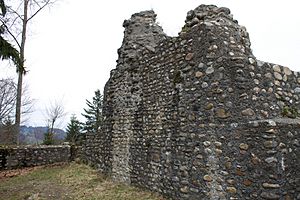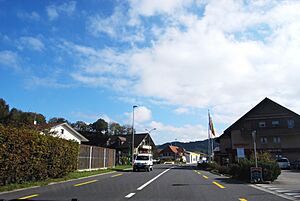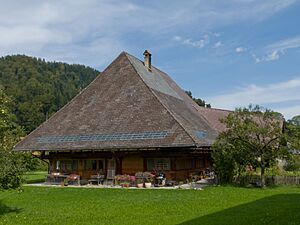Bowil facts for kids
Quick facts for kids
Bowil
|
||
|---|---|---|
 |
||
|
||
| Country | Switzerland | |
| Canton | Bern | |
| District | Bern-Mittelland | |
| Area | ||
| • Total | 14.69 km2 (5.67 sq mi) | |
| Elevation | 733 m (2,405 ft) | |
| Population
(Dec 2020 )
|
||
| • Total | 1,354 | |
| • Density | 92.17/km2 (238.72/sq mi) | |
| Postal code |
3533
|
|
| Surrounded by | Linden, Oberhünigen, Oberthal, Röthenbach im Emmental, Signau, Zäziwil | |
Bowil is a small town, also called a municipality, located in the Bern-Mittelland area of the canton of Bern in Switzerland. It's a quiet place with a rich history and beautiful natural surroundings.
Contents
Discovering Bowil's Past
Bowil was first mentioned in official records way back in 1299, known then as Bonwile.
The village was once part of a larger territory called the Herrschaft of Signau. The noble family, the Freiherren of Signau, built their castles, Alt-Signau and Neu-Signau, between Bowil and Signau. Today, the ruins of both castles are actually located within Bowil's borders!
During the Middle Ages, Bowil was mostly controlled by the Freiherr of Signau. However, other landowners and local farmers also had rights or property in the village.
In 1528, the city of Bern adopted the Protestant Reformation, which was a big change in religion. Bowil quickly followed this new faith. But in the years after, it became a safe place for Anabaptists, a group with different religious beliefs. To encourage the Anabaptists to join the Swiss Reformed Church, Bern built a church in Bowil in 1720. By 1930, this church became the main church for the Bowil-Oberthal area.
How Bowil's Economy Grew
For a long time, Bowil's economy depended on subsistence agriculture. This means farmers grew just enough food to feed themselves and their families.
However, in the late 1700s, farmers started growing grass to make hay for cattle. By the 1800s, dairy farming (raising cows for milk and cheese) became more important than traditional farming.
In 1901, a railway station opened in Bowil, connecting the village to the rest of Switzerland. This made it easier to transport goods and encouraged small factories to move to Bowil. Even with new industries, in 1990, about one-third of all jobs in the village were still in agriculture.
Exploring Bowil's Geography
Bowil covers an area of about 14.7 square kilometers (about 5.7 square miles). A large part of this land, about 55%, is used for farming. Forests cover about 39.6% of the area. The rest is made up of buildings, roads, and a small amount of rivers.
Most of the forested land is dense forest, with a small part covered by orchards. For farming, about 20.3% is used for growing crops, and 33.4% is used for pastures where animals graze. All the water in Bowil is from flowing rivers or streams.
Bowil is located between two important rivers, the Aare River and the Emme River. Its southern border is the Kurzenberg hill, and its northern border follows the Blasenfluh river. The municipality includes the main village of Bowil, along with smaller areas like Oberhofen, Rünkhofen, and Steinen, plus many scattered farmhouses.
Bowil's Coat of Arms
The official symbol, or blazon, of Bowil's coat of arms shows a golden shield with three green fir tree branches growing from a red hill with three peaks.
People of Bowil
Bowil has a population of about 1,358 people (as of December 2010). Only a small percentage, about 2.0%, are people from other countries. Over the last ten years (2000-2010), the population has grown slightly by 0.8%.
Most people in Bowil, about 98.4%, speak German as their main language. A smaller number speak Albanian (0.5%) or English (0.4%).
In 2008, the population was almost evenly split between males (51.6%) and females (48.4%). Most residents were born either in Bowil itself (46.2%) or elsewhere in the same canton (41.8%).
Age Groups in Bowil
As of 2010, children and teenagers (ages 0–19) make up 23.1% of the population. Adults (ages 20–64) are the largest group at 60.9%, and seniors (over 64 years old) make up 16%.
Most people in Bowil are married (632 individuals in 2000), while 594 people were single.
Homes in Bowil
In 2000, there were 130 households where only one person lived, and 64 households with five or more people. Most apartments (88.3%) were lived in all the time. In 2011, about 2.88% of homes were empty.
The number of people living in Bowil has changed over time:

Important Buildings in Bowil
One special building in Bowil is the Hochstud house. It's listed as a very important heritage site for Switzerland. These houses have a unique roof design.
Bowil's Economy Today
Bowil is home to Ferdinand Steck Maschinenfabrik, a company that makes special equipment for building roads and railways.
In 2011, Bowil had a very low unemployment rate of 0.76%, meaning almost everyone who wanted a job had one. In 2008, there were 397 people working in the municipality.
- About 152 people worked in agriculture (farming).
- About 106 people worked in the manufacturing and construction industries.
- About 139 people worked in the service sector, which includes jobs like sales, hotels, restaurants, and education.
Many people who live in Bowil travel to other towns for work. In 2000, 438 residents left Bowil for their jobs, while only 142 people came into Bowil to work. Most people (56.1%) used a private car to get to work, while 11% used public transportation.
Religion in Bowil
Based on a 2000 survey, most people in Bowil (87.2%) belonged to the Swiss Reformed Church. A smaller group (3.1%) were Roman Catholic. There were also people who belonged to other Christian churches (6.20%) and some who were Islamic (1.34%). A small number of people were Buddhist, or did not belong to any church.
Education in Bowil
In Bowil, about 35.8% of the population has finished upper secondary education (like high school). About 6.5% have gone on to higher education at a university or a special college called a Fachhochschule.
The school system in the Canton of Bern starts with one year of optional Kindergarten. After that, students go to six years of Primary school. Then, they attend three years of lower Secondary school, where they are grouped by their abilities. After lower Secondary, students can continue their education or start an apprenticeship (on-the-job training).
During the 2010–11 school year, 129 students attended schools in Bowil.
- There were 2 kindergarten classes with 16 students.
- There were 6 primary classes with 94 students.
- There was one lower secondary class with 19 students.
Bowil also has its own library, the Schul- und Gemeindebibliothek Bowil. In 2008, the library had 5,790 books and other media, and people borrowed 13,362 items that year.
See also
 In Spanish: Bowil para niños
In Spanish: Bowil para niños








